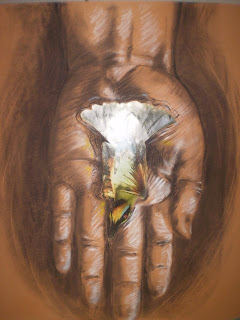
With the number of environmental issues being given media coverage at this point in our history, it is easy to overlook one with as benign a title as Eastern Garbage Patch. The title appeared on the cover of one of my favorite periodicals, Discovery Magazine, but I was not prepared for either the article or the portrait it paints of our future. Eastern for me, has always meant somewhere distant. Too far away to factor into my list of things to worry about. Garbage is something I know about as well. I take it to the curb. On a good day it is a manageable bag which gets thrown on a truck with my neighbors trash and voila, we never see it again. Until recently, the word patch had always held something of wondrous mystery for me. My fathers potato patch rating easily as the eighth wonder of the world as I was growing up in northern Ontario. So The Eastern Garbage Patch, I assumed, would be an easy read.
For the uninitiated, the Eastern Garbage Patch, a name given it by scientists who are attemtpting to deal with it, is a floating mass of debri which has accumulated in the Pacific Ocean over centuries, is 300 ft. deep and although statistics vary, Discovery magazine describes it as one and one half times the size of the United States. At half the size, this is no patch.
According to the article, scientists around the world are trying to determine what to do with this ever increasing mass of garbage and the scope of the problem and ways to deal with it have so far eluded them. Given the location of the "patch" between Hawaii and California, one can pretty fairly assume that Canada has made a substantial contribution. And yet I have never heard our environment ministry speak of The Eastern Garbage Patch. It was for this reason that in September, I wrote to our Governor General Michaelle Jean.
Her Excellency
the Right Honourable Michaëlle Jean
Governor General of Canada
Rideau Hall
1 Sussex Drive
Ottawa, Ontario
K1A 0A1
Dear Excellency,
It was with no small amount of interest that I read of your concern, (today's Toronto Star), for environmental issues. I have only just recently read an article in Discovery magazine which outlines the severity of one issue in particular. It describes what scientists and environmentalist are calling the Eastern Garbage Patch, a collection of garbage which has been accumulating over the centuries in the Pacific, west of the US and stretching all the way to Hawaii. Apparently this "patch" is one and a half times the size of the US and up to 300 ft. deep! Until reading this article I had no idea....nor do I suspect do most people. This is no small environmental issue....this is a tragedy which needs to be addressed today! I am now retired and want to devote my time to a cause worthy of my attention. This one strikes me as just such a cause. I would request that you have your office contact me, at your convenience with suggestions as to what avenues you would advise in an effort to have impact. I don't know if Canadian fisheries are involved in any current attempt at clean up although I suspect they should be. I highly recommend, given your interests, that you make yourself aware of the publication cited above. It was quite the eye opener and it was not wasted on me nor do I believe will it be wasted on you.
Respectfully
Sharon Wright
Six months have passed since I sent this letter and I have had no response, nor have I heard the Governor General mention this topic publicly. I invite readers of my Blog to write to Her Excellency expressing their concerns on this issue. It is not one which is going to go away without a focused effort on the part of all countries with a view to the Pacific Ocean. I would like to think that Canada could be instrumental in playing a leadership role in this all too important effort.

